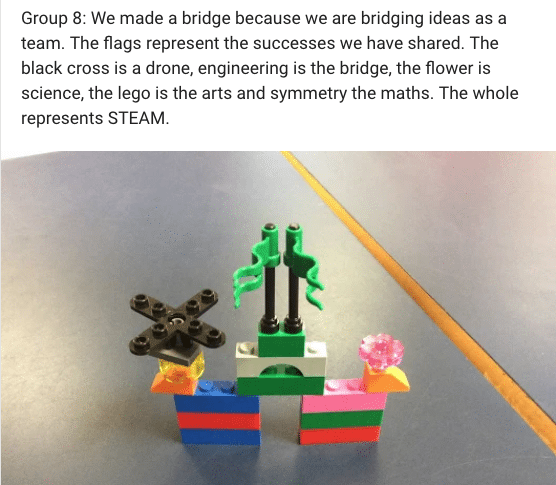Towards a guided creativity
This introduction evaluates the combination of STEAM and design thinking.
The introductions to weeks 1 and 2 already pointed out that the role of arts, as an integrated discipline into STEM (= STEAM), is found in many ways:
- art as a form of inspiration: a piece of art could be the trigger of a problem solving process;
- art as a form of presentation: in the end of a STEAM project, the solution can be presented in an atypical way, for example by a dance performance;
- art as a form of communication and collaboration during the learning process;
- art as a form of creativity, inherent in the process.
Our student teachers have been keen to embrace these ideas:

Student reflection on STEAM from the University of Northampton
As explained in the previous introductions, the DLaB pedagogical approach this year was based on an interpretation of design thinking (Kimbell, 2015) that begins with empathising, followed by defining a key question, moving on to idea generation, framing a problem and sharing a creative solution.
The double diamond model below visualises two divergent and two convergent thinking stages resulting in a vision and plan, and a creative solution.

Figure * Adaptation of the UK Design Council’s ‘Double Diamond’ model (https://www.ebi.ac.uk/training/online/course/user-experience-design/phases-design)
Many researchers promote the link between arts and design thinking, and therefore in DLaB this year we combined both into one solid story.
But what is the relationship between the two approaches and what is their value for inquiry based learning? As we dig deeper into the features of art as a creative discipline we find playfulness, deconstruction and reconstruction, performance, collaboration, idea generation, creativity, creating something new and dealing with the risk of failure,…
As much as it is a source of inspiration, the process an artist follows stays difficult to define.
Conversely, the design thinking (DT) process is easier to review and to talk about. Additionally, the design thinking process is itself inherently creative (the divergent phases count for as many solutions as possible) and can adapt to art as a form of inspiration, presentation and collaboration (see above). So all the ways in which art appears into STEAM projects are represented in a structured and well guided manner by the DT process.
One wonders if the design process could be too formalised and thus counterproductive in terms of constraining the scope for creativity so necessary to the process of design. However, as Herbert Simon remarks, the process of design can be a valued activity in itself: “the act of envisioning possibilities and elaborating them is itself a pleasurable and valuable experience. Just as realised plans may be a source of new experiences, so new prospects are opened up at each step in the process of design. Designing is a kind of mental window shopping.” (Simon, 1996, p. 164).
In the example below, students are using Lego to support their reflections on STEAM learning.

Creating models can help to visualise ideas
Visualising ideas into 3D models can give students the confidence to express their ideas without fear of failure as the model acts as a design thinking prototype that can easily be modified. Collaborative model building encouraged the flow of creative thinking within the group.
In this way, DT not only gives the advantage of constantly recreating new possibilities as being new starting points, but the process has embedded creativity, albeit in a well-organised way.
Therefore it is an excellent tool to promote inquiry in educational settings within and beyond the STEAM disciplines.
References
Kimbell, L. (2015) Rethinking Design Thinking: Part I, Design and Culture, 3:3, 285-306, DOI: 10.2752/175470811X13071166525216
After you have reviewed these materials click on Mark Complete at the bottom of this page to continue.
